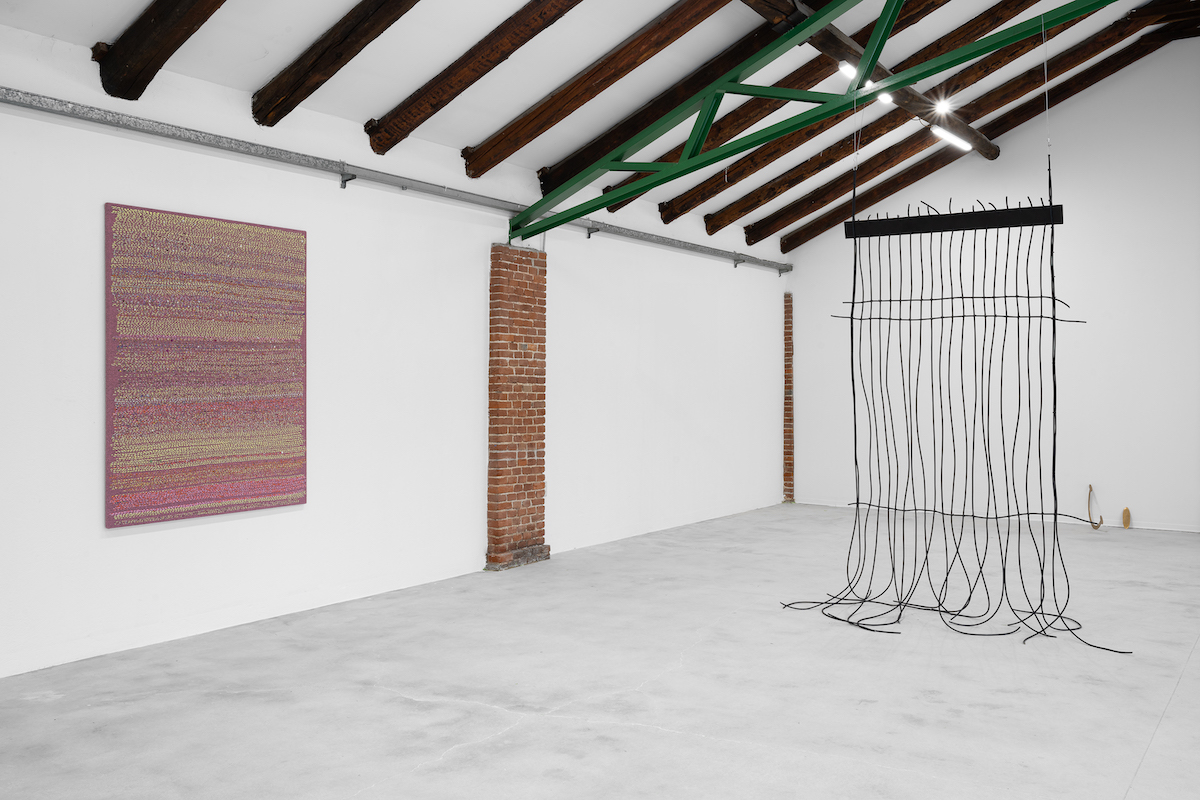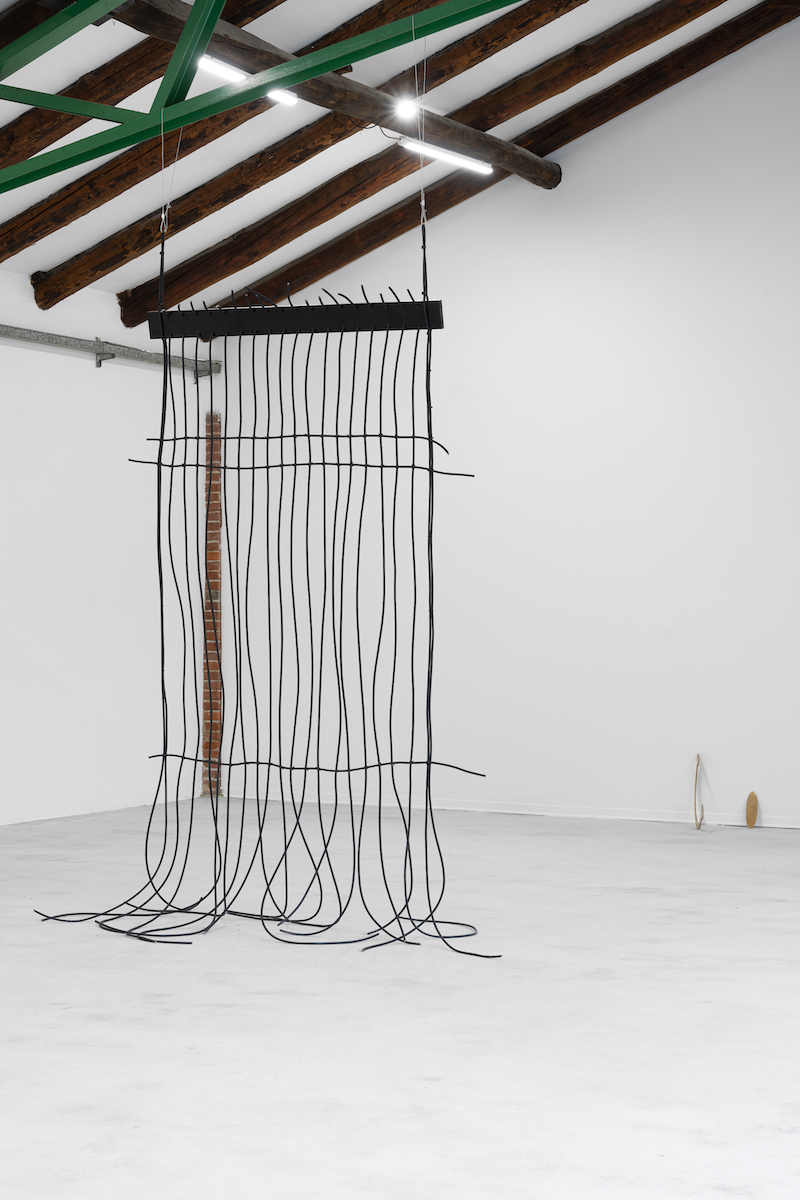EVERYTHING TENDS TO ASCEND



















EVERYTHING TENDS TO ASCEND
(PART ONE)
curated by Francesco João
Virginia Ariu, Luisa Brandelli, Francesco João, Gabriel Kuri
Opening Thursday 20th June, 6pm
From June 21st – September 1st 2024
Société Interludio is pleased to announce Everything tends to ascend (part one), curated by Francesco João, with works by Virginia Ariu (Turin, 1993), Luisa Brandelli (Porto Alegre, 1990), Francesco João (Milan, 1987) and Gabriel Kuri (Mexico City, 1970).
Her family was probably one of those who at some point in history, and perhaps still do, controlled half of the black market in diamonds coming into Holland from South Africa and Congo, or at best corruption of Members of the European Parliament through foundations. But she was very keen to let us know how crucial it was to rediscover the work of such an artist who back in the years (not that far back – during the same time Katharina Fritsch was realising Madonnefigur, 1982) painted like the Gauguin of the Tahitian phase, although she had never had the chance to admire his work.
For my part, although I may have felt genuine sympathy for the artist in question, if I had told her that I gave a shit about the work, she would not have hesitated to accuse me of Eurocentrism or something. Yet to me, to look at the work with exotic interest, as one would look at an incandescent light bulb invented in the middle of the desert while the rest of humanity has largely switched to LED, seems pure Jardin d’Acclimatation curiosity.
Her brother had spent three thousand euros to stay a week at a spiritual retreat in the middle of the Amazon rainforest on ayahuasca. Interestingly, my mother, an Amazonian indigenous woman who was born there, had never even heard of ayahuasca, causing me to grow a vague suspicion that this “millenary tradition” was more like a penny-pinching scheme for young preppies in spiritual crisis. On the other hand, even in the young man’s next destination, Ibiza, rituals that in their own way were connected to the spirit were consumed, just as they were at the Mudd Club in New York in the early 1980s – the stage for Dan Graham’s essay from which the exhibition starts -, in the rave acid of Manchester in the following decade, in the provincial pill-popping clubs of my high school years, those of Berlin and so on.
Some seven hundred years earlier, the young Scrovegni, concerned for the salvation of his usurer father’s soul, commissioned Giotto to paint the famous cycle of frescoes in the family chapel, including the Last Judgement and the monochrome Allegories of the Vices and Virtues.
The exhibition finds its starting point in the writing of the famous American conceptual artist Dan Graham (1942-2022), Rock my Religion (1982-1984). This essay (and video) explores the connection between religion and rock music, laying the groundwork for investigating the relationship between art and transcendence, as well as reflecting on the means of elevation.
Graham’s work opens with images of punk musicians writhing on stage to the beat of an electric guitar, alternating with woodcut illustrations of the Shakers, members of an 18th and 19th century religious movement known for their fervent dances and contortions performed to purify themselves from evil. This visual and thematic contrast guides the entire exhibition, offering a reflection on how different cultures and historical periods have invested the arts with a practical function, using them as a tool to transcend material reality.
The exhibition in September ’24 will see a moment of simultaneity in two different geographical locations: in Europe, in Turin, and in South America, in Rio de Janeiro. This dual exhibition venue not only broadens the audience and cultural context, but also emphasises the universality of the themes treated without hierarchies as opposed to the speculative exoticism that has characterised recent years. The collection of works presented acts as a series of portals inviting reflection on transcendence, desire and elevation.
Virginia Ariu was born in Turin in 1992 and currently lives and works in Zurich. She studied Painting at the Albertina Academy of Fine Arts in Turin and Visual Arts at Écal, University of Art and Design in Lausanne. Recent solo exhibitions have taken place at City Galerie Wien, Vienna, at Lighthaus, with artist Vittorio Santoro, in Zürich, at Come Over Chez Malik’s, Hamburg, at Almanac Projects, Turin, at Forgo, Berlin, a solo project curated by Roger Van Voorhes in Brooklyn, New York, at Ateliers Bellevaux, Lausanne, at Alienze, with artist Shirin Yousefi, in Lausanne, and at No Conformism, Milan. Recent group exhibitionsinclude Robert Walser Zentrum, Bern, Royal Flush Gallery, Oslo, Galerie Kirchgasse, Steckborn, City Galerie Wien, Vienna, Hamlet, Zurich, Düsseldorf Photo+, Düsseldorf, Stiftung BINZ39, Zurich, Solutions, Milan, Galleria Acappella, Naples, and Weiss Falk, Basel. She has participated in residencies at SOMA, Mexico City, Sihl Delta, Zurich, and La Becque, La Tour-de-Peilz, Switzerland.
Luisa Brandelli (1990, Porto Alegre, lives and works in São Paulo) developed her first works in 2015. In 2016 she participated in her first exhibition when she was selected for Abre Alas at the gallery A Gentil Carioca. She took part in exhibitions in galleries such as Bolsa de Arte, Fortes D’Aloia e Gabriel, A Gentil Carioca, among others; and public spaces such as Casa de Cultura Mario Quintana, Museu de Arte Contemporânea do Rio Grande do Sul and Centro Municipal de Arte Hélio Oiticica, where she held the solo exhibition Somewhere very, very wild in 2022. In the same year she won the residency award at the Inclusartiz Institute, to then take part in the exhibition Hora Grande, at SP-Arte. In 2021, she gained prominence at Revista Zum’s photobook festival with the publication “Revista Urgência”. In 2024, she will hold her first solo exhibition in São Paulo, at Espaço Auroras.
Francesco João (b. 1987) lives and works between São Paulo, Brazil, and Milan, Italy. His exhibitions include: SSD, Gathering, London (2024); Seven Segment Display, Fondazione Zimei, Rome (2023); Sem título, por enquanto, Marli Matsumoto, São Paulo (2023); x_minimal, curated by Friederike Nymphius, Cassina Projects, Milan (2021); 1550 San Remo Drive, Hot Wheels, Athens (2020); Francesco João, Mendes Wood DM, Brussels (2019); BRAZIL. Knife in the flesh, PAC – Padiglione d’Arte Contemporanea, Milan (2018); Donkey Man, Mendes Wood DM, São Paulo (2017); A Terceira Mão, curated by Erika Verzutti, Fortes D’Aloia Gabriel, São Paulo; Everything tendsto ascend. Or not., Pivô, São Paulo (2016); Summertime ’78, Kunsthalle São Paulo, São Paulo (2015); Nimm’s Mal Easy, Ausstellungsraum Klingental, Basel (2015); Dizionario di Pittura, Galleria Francesca Minini, Milan (2014).
Gabriel Kuri (Mexico City, 1970) lives and work between Mexico City and Bruxelles. His work has been shown in solo exhibition in international and private Institutions, including: The Douglas Hyde Gallery, Dublin, Ireland (2020); WIELS, Brussels, Belgium (2019); Oakville Galleries, Centennial Square, Oakville, USA (2018); Alte Fabrik, Rapperswil, Switzerland (2016); Aspen Art Museum, Aspen USA (2015); The Common Guild, Glasgow, UK (2014); Parc Saint Leger-Centre d’art contemporain, Pougues-les-Eaux, France (2013); Bergen Kunsthall, Bergen, Norway (2012); Institute of Contemporary Arts, Boston, USA (2011); Museion, Bolzano, Italy (2010); MUHKA – Museum of Modern Art Antwerp, Antwerp, Belgium (2003); Museo Tamayo, Mexico City, Mexico (2000); Le Magasin – Centre National d’Art Contemporain, Grenoble, France (1996). He has also taken part in many group exhibitions in Institutions such as: Museo Amparo, Puebla, México (2019); Kunstmuseum St. Gallen, Gallen, Switzerland (2018); Whitechapel Gallery, London, UK (2017); Musée des Arts Décoratifs, Paris, France (2016); MCA – Museum of Contemporary Art Chicago, Chicago, USA (2015); Centre Pompidou, Paris, France (2014); Walker Art Center, Minneapolis, USA (2012); Carrè d’Art – Musèe d’Art Contemporain de Nimes, Nimes, France (2011); The Sculpture Centre, New York, USA (2009); The New Museum, New York, USA (2007); MOCA – The Museum of Contemporary Art Los Angeles, Los Angeles, USA (2006); CCA WattisInstitute for Contemporary Arts, San Francisco, USA (2005); Serpentine Gallery, London, UK (2004); MoMA PS1, New York, USA (2002). His work has been shown in biennials and international group exhibitions such as: Biennial of Graphic Arts Ljubljana, Ljubljana, Slovenia (2017; 2015); East Wing Biennial, London, UK (2016); 12th Havana Biennial, Havana, Cuba (2015); 54th Biennale di Venezia, Venice, Italy (2011); 5th Berlin Biennial, Berlin, Germany (2008); 50th Biennale di Venezia, Venice, Italy (2003); Tirana Biennal, Tirana, Albania (2001).

